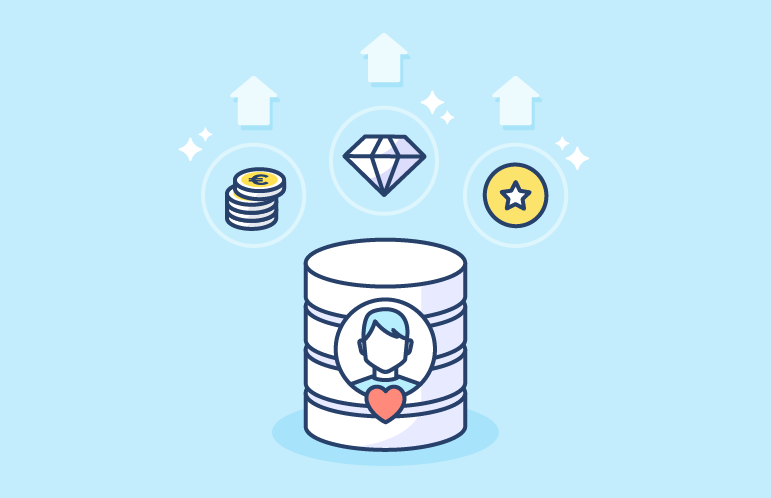Optimizing Customer Lifetime Value with CDP: strategies for focusing on customer value


Category: CRM strategy
Customer Lifetime Value represents the total value a customer brings to a company over the course of his or her relationship with it. It is an important indicator for CRM, because by comparing it with the CAC, teams are able to determine the expected ROI of their marketing actions.
To calculate Customer Lifetime Value, simply multiply the average transaction value by the average purchase frequency over a given period, then multiply the result by the average customer lifetime.
CLV = [(Average basket) X (Purchase frequency/year)] X [Average customer lifetime (in years)]
The CLV will therefore make it possible to identify the most profitable customers, so that personalized actions can be taken to increase their value, and it will also serve as a target for increasing the value of other core customers.
This is how the Customer Data Platform will ensure that every piece of data, every click, every purchase, every interaction becomes the key to unlocking the potential in every customer relationship. Focusing on CLV with a CDP implies a strategic, data-centric approach to maximizing the long-term value of every customer.
The importance of Customer Lifetime Value in marketing and loyalty strategy is paramount. It enables companies to :
In one of its analyses, Forrester Research reveals that companies that focus on improving CLV see an average 17% increase in revenues over two years. This shows the significant impact that a high CLV has on a company's profitability and growth.
A Customer Data Platform is a system that unifies customer data from multiple sources into a centralized database. It provides a 360-degree view of the customer, enabling companies to better understand and serve their customers.
The advantages of a CDP include :
Effective customer data collection is crucial to maximizing CLV. A CDP can integrate data from a variety of sources:
Data quality is paramount: on average, large companies lose $15 million a year due to the poor quality of the data they possess. By centralizing data, it is possible to create complete and accurate customer profiles, essential for in-depth CLV analysis.
Visit personalization of interactions is crucial to any relevant marketing strategy. Thanks to the unified data of a CDP, companies can offer tailor-made experiences, reinforcing engagement and loyalty, and increasing CLV.
By adopting fine-grained segmentation based on specific behaviors and purchasing preferences (over and above traditional demographic criteria), companies can tailor their marketing strategies to each customer group. This targeted approach enables more relevant messages to be delivered, increasing the likelihood of repeat purchases and prolonging the duration of the customer relationship.
By analyzing purchase history and browsing habits, CDP feeds product recommendations. For example, an online tableware e-shop might suggest table accessories to match a recent purchase.
CDPs make it possible to personalize marketing content, such as newsletters or dynamic home pages, according to customers' interests and profiles. Engaging customers with content that resonates with them strengthens their commitment and loyalty, boosting their long-term value.
Understanding the customer lifecycle enables us to propose relevant offers, such as loyalty programs for regular customers or reactivation strategies for dormant customers.
CDPs centralize data from all contact points, ensuring a seamless customer experience across all channels. They also enable the approach to be adjusted instantly according to the customer's actions. For example, a personalized discount offer can be triggered immediately after the abandonment of an online shopping cart.
A CDP makes it possible to design marketing campaigns based on actual customer behavior and preferences. L'marketing automation, enriched by CDP data, enables the launch of real-time, more targeted and more effective campaigns. Fueled by accurate, up-to-date data, these campaigns can tailor messages and offers to each customer's specific interests and actions, increasing their relevance and impact. In addition, advanced segmentation facilitates the creation of homogeneous customer groups, enabling campaigns to be personalized at a granular level, for further optimization.
Customer loyalty is an essential lever for increasing customer lifetime value (CLV). Loyalty strategies based on CDP data can include:
By taking a personalized, proactive approach, these loyalty strategies not only retain existing customers, but also turn satisfied customers into brand ambassadors, encouraging the acquisition of new customers through positive word-of-mouth.
To maximize CLV, it is essential to measure and analyze it regularly. A CDP provides the tools needed to :
According to McKinseycompanies that use advanced analytics for decision-making are 23 times more likely to acquire customers, and 19 times more likely to retain them!
By improving CLV through a data-driven approach, companies aren't just surviving in a tough economic environment - they're thriving. CDP is not just a technological tool, it's a catalyst for transformation that puts the customer at the heart of every decision. As the future takes shape with personalization and customer experience as key differentiators, the companies that master the art of using their data to enrich their customers' value throughout their lifecycle will be the ones writing tomorrow's Success Stories.
Contents